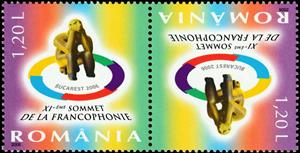Tete-Beche: Thinker, Figure of Neolithic Hamangia Culture ~5200-4500 BC (Romania 2006)
Thinker, Figure of Neolithic Hamangia Culture ~5200-4500 BC (Romania 2006)
28 September (Romania ) within release 11th World Summit of the Francophonie, Bucharest goes into circulation Tete-Beche Thinker, Figure of Neolithic Hamangia Culture ~5200-4500 BC face value 2*1.20 Romanian leu
| Tete-Beche Thinker, Figure of Neolithic Hamangia Culture ~5200-4500 BC in catalogues | |
|---|---|
| Michel: | Mi: RO 6127KD |
| Colnect codes: | Col: RO 2006.09.28-01a |
Tete-Beche is horizontal format.
Tete-Beche Thinker, Figure of Neolithic Hamangia Culture ~5200-4500 BC it reflects the thematic directions:
A conference is a meeting, often lasting a few days, which is organized on a particular subject, or to bring together people who have a common interest. Conferences can be used as a form of group decision-making, although discussion, not always decisions, is the primary purpose of conferences. The term derives from the word confer.
Sculpture is the branch of the visual arts that operates in three dimensions. Sculpture is the three-dimensional art work which is physically presented in the dimensions of height, width and depth. It is one of the plastic arts. Durable sculptural processes originally used carving (the removal of material) and modelling (the addition of material, as clay), in stone, metal, ceramics, wood and other materials but, since Modernism, there has been almost complete freedom of materials and process. A wide variety of materials may be worked by removal such as carving, assembled by welding or modelling, or moulded or cast.

